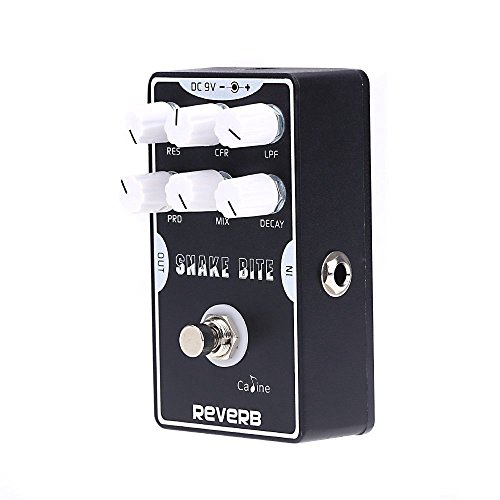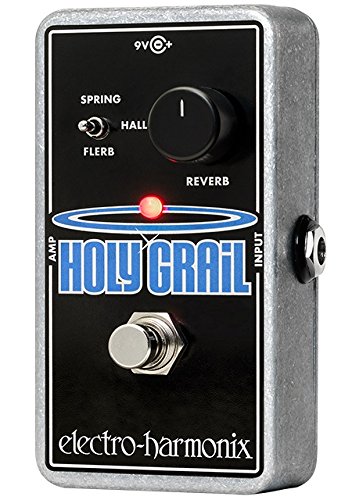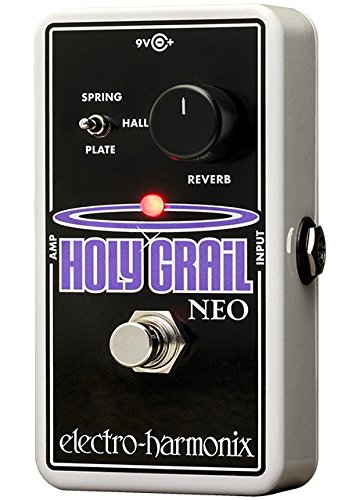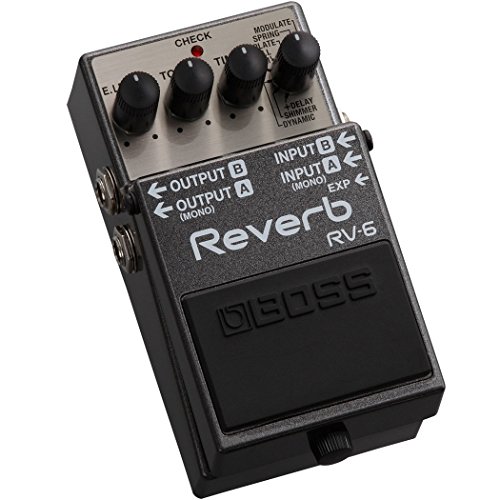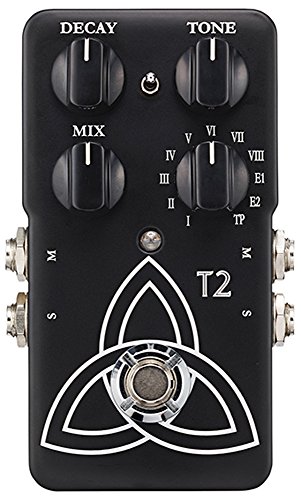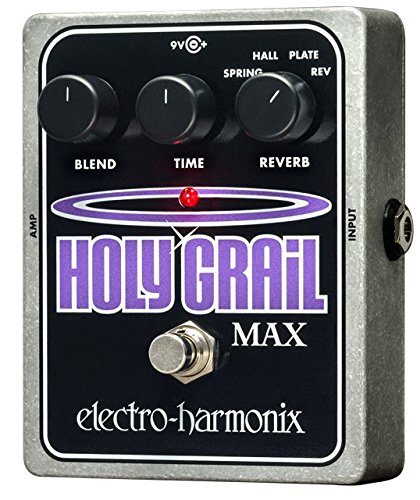We're going to tell you why the best reverb pedal is so important for musicians. If you've just purchased a guitar and want to master it, but aren't completely satisfied with the sound that you get, try adding a pedal to the guitar. The sound will be completely transformed.
Although electric guitar amps come equipped with a built-in reverb pedal, it isn't as effective as having an external pedal. The reverb pedal is capable of giving you more control over your playing. The outcome is much better than what you'd get with a simple electric guitar and an amp.
You may also like - Top 10 Flanger Pedals Review.
Table of Contents
- Best Reverb Pedals for Guitarists in 2024
- 1. TC Electronic Hall of Fame Reverb Pedal
- 2. MXR M300 Reverb Guitar Effects Pedal
- 3. Behringer DR600 Digital Stereo Reverb Effects Pedal
- 4. Biyang Rv-10 3-mode Stereo Reverb Guitar Effects Pedal Stereo-designed TRI Reverb
- 5. Caline Reverb Guitar Effect Pedal True Bypass Aluminum Alloy Housing CP-26
- 6. Electro-Harmonix HOLY GRAIL NANO Reverb Pedal
- 7. Electro-Harmonix Holy Grail Neo Reverb pedal
- 8. Boss RV-6 Digital Reverb
- 9. TC Electronic T2 Reverb Pedal with TonePrint
- 10. Electro-Harmonix Holy Grail Max Reverb
- Reverb Pedal Buyers' Guide
- FAQs
If you're looking to spice up your guitar sound, there's no better way than adding a reverb pedal to your setup. If you're shopping around for the best reverb pedal, you'll soon realize that there are a wide number available. To make things easier for you, we've come up with a list of the best reverb pedals. This will make your reverb pedal shopping experience hassle-free.
At a glance: Our top 3 picks
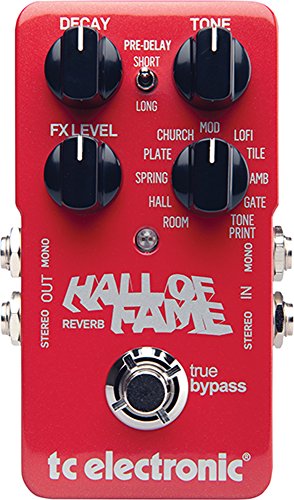
TC Electronic Hall of Fame Reverb Pedal

- Capable of true bypass, so there's no loss of tone.
- Flexible and can fit into any setup with ease; comes equipped with stereo in and out.
- Gives you clear, crisp tonal quality.
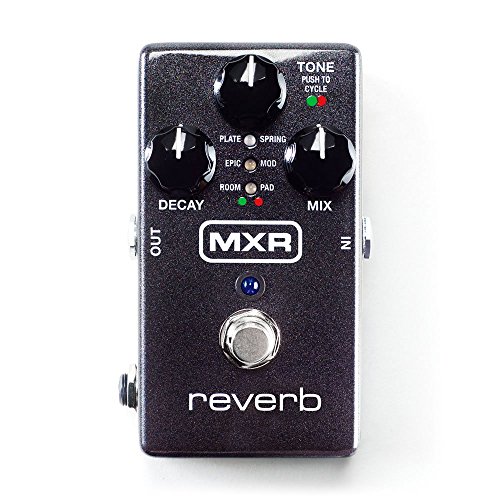
MXR M300 Reverb Guitar Effects Pedal

- Capable of true bypass, so there's no loss of tone.
- Flexible and can fit into any setup with ease; comes equipped with stereo in and out.
- Gives you clear, crisp tonal quality.
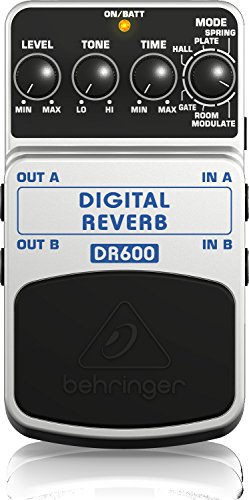
Behringer DR600 Digital Stereo Reverb Effects Pedal

- Capable of true bypass, so there's no loss of tone.
- Flexible and can fit into any setup with ease; comes equipped with stereo in and out.
- Gives you clear, crisp tonal quality.
Best Reverb Pedals for Guitarists in 2024
1. TC Electronic Hall of Fame Reverb Pedal
One thing that you'll tend to experience with other pedals is a loss of tone. That's not the case with this reverb pedal from TC Electronic. It'll make your guitar sound way better than you're used to, thanks to the room, hall, spring reverb setting, and more. The complete, comprehensive control you get with this reverb pedal is simply amazing. Control each reverb mode with the easy-to-use control knobs.
The TC Electronic Hall of Fame 2 Reverb Pedal can give you all the reverberation you could ever want from your electric guitar. It's one of the best reverb pedals around.
Pros:
+ Capable of true bypass, so there's no loss of tone.
+ Flexible and can fit into any setup with ease; comes equipped with stereo in and out.
+ Gives you clear, crisp tonal quality.
Why We Liked It - As far as the functionality of the TC Electronic Hall of Fame 2 Reverb Pedal is concerned, this bad boy is flawless. It might not be equipped with a useful power supply but they're easy enough to pick up, so don't let that factor deter you.
2. MXR M300 Reverb Guitar Effects Pedal
This MXR M300 reverb pedal has the perfect blend of functionality and versatility. It comes with six different reverb tones that are perfectly crafted and fine-tuned by the expert MXR team. The setup of this reverb pedal is fairly easy. It comes with Constant Headroom Technology, which allows it to deliver 20 volts of headroom. The six reverb styles give it all the versatility in the world, which is something you will find in fairly expensive plug-in and rack units. The MXR M300 Reverb also features a trails bypass mode with a buffered bypass.
Pros:
+ Comes with six distinct reverb styles.
+ Every reverb style is richly detailed like you would find with some very high-end models.
+ It comes with delay trails modes and true relay bypass.
Why We Liked It - With its rugged construction, variety of reverb styles, and trails bypass mode, the MXR M300 Reverb Guitar Effects Pedal is one of the best reverb pedals you'll see out there. The best part? It isn't expensive.
3. Behringer DR600 Digital Stereo Reverb Effects Pedal
Behringer has been manufacturing state of the art audio solutions for decades. The company is rated pretty highly in the eyes of audio professionals and audio technicians worldwide. Its consistent quality has won lifelong fans.
The Behringer DR600 Digital Stereo Reverb Effects Pedal is another amazing product at an amazingly low price point. This stereo reverb pedal is the first choice of many musicians. It's a 24-bit high-resolution reverb pedal that in-house the six most desired reverb styles, including a modulated reverb sound.
Pros:
+ Comes with 24-bit high-resolution reverbs of six different types: Spring, Hall. Plate, + Room, Modulate, and Gate.
+ Capable of great sound-shaping since it comes equipped with dedicated tone, time, mode, and level controls.
+ Great price point for number of features.
Why We Liked It - The Behringer DR600 Digital Pedal is a top quality product from one of the best in the business at a low price.
4. Biyang Rv-10 3-mode Stereo Reverb Guitar Effects Pedal Stereo-designed TRI Reverb
Small, durable, stereo reverb pedal. Need we say more? The Biyang Rv-10 3 mode delivers all the control you could ever need from a reverb pedal. With a toggle switch and three different reverb modes, this is another affordable option that will offer a great reverb mix.
Pros:
+ Equipped with all metal steel enclosure for enhancing durability.
+ Analog circuit designs that enable it to deliver realistic reverb.
+ Has a toggle switch for selecting between three different modes, room, spring, and hall.
Why We Liked It -It's almost impossible to pick out a single flaw here, making this compact pedal one of the best reverb pedals around.
5. Caline Reverb Guitar Effect Pedal True Bypass Aluminum Alloy Housing CP-26
Ever wondered why electric guitars don't sound complete even with the best guitar amps? With the Caline Reverb Guitar Effect Pedal True Bypass CP-26 installed in your guitar setup, you'll get the richest sound you could imagine.
Pros:
+ This reverb guitar pedal can easily adjust to all reverb levels.
+Won delay function to maintain the original sound quality while getting a good reverb effect.
+ It comes with low pass filter LPF that helps adjust the radio frequency component of reverb.
Why We Liked It - It'd be tough to find a better reverb pedal than the Caline Reverb Guitar Effect Pedal at this price point.
6. Electro-Harmonix HOLY GRAIL NANO Reverb Pedal
This reverb pedal houses three distinct reverb styles. The spring reverb style it has on offer will take you to the classics and leave you mesmerized. Next in line is the hall reverb, which is also pretty detailed, as is the final reverb style.
The design of the Electro-Harmonix HOLY GRAIL NANO Reverb Pedal is so compact that it's hard to believe it can deliver such a spacious hall reverb. Plus, the Flerb that you get is also top quality.
Pros:
+ The spring reverb is completely unmatched.
+ It comes with a power supply (96DC-200BI), so there's no need for batteries.
Why We Liked It - If you're a fan of the classic spring reverb, the Electro-Harmonix HOLY GRAIL NANO Reverb Pedal is the perfect reverb pedal for you.
7. Electro-Harmonix Holy Grail Neo Reverb pedal
This reverb pedal gives you all the control you need when playing an electric guitar. The output is amazing. It comes with three different types of reverbs and a reverb mode switch to select whichever reverb you want without issue.
Pros:
+ Comes with true bypass switching ensuring that the signal is always uninterrupted.
+ Reverb knob controls enable you to easily go from 100 percent dry to 100 percent wet.
+ The sound of this reverb pedal is the same as that of Holy Grail Nano.
Why We Liked It - With all the control and the great sound quality that this reverb pedal has on offer, it is surely one of the best out there.
8. Boss RV-6 Digital Reverb
Boss is the real deal when it comes to highly-rated audio solutions. It's a preferred brand of audiophiles and audio professionals all around the globe. As far as the best reverb pedals go, it's certainly the industry leader. The RV-6 Digital Reverb is no exception.
Pros:
+ Simple control options.
+ Equipped with 8 sound modes for major versatility.
Why We Liked It - The RV-6 Digital Reverb is easy to use. It's such a versatile reverb pedal - we totally understand why so many folks love it.
9. TC Electronic T2 Reverb Pedal with TonePrint
If you're a reverb freak and can't imagine playing your guitar without that sick sound, you need this reverb pedal. Control and complete sound all in one convenient package. This is reverb at its finest.
Pros:
+ Equipped with ten gorgeous reverb sounds.
+ Made from high-quality components, ensuring the durability of this product.
Why We Liked It - With so many reverb options and such high-quality craftsmanship, you can't go wrong with this reverb pedal.
10. Electro-Harmonix Holy Grail Max Reverb
With its compact design, this reverb pedal is highly portable, and the sound you get from it is top quality. The major features of this are the plate and reverse reverb which allows you to get seriously creative.
Pros:
+ It is a true bypass, making sure the signal remains at its peak whenever you use it.
+ Comes with four different reverb types including spring, hall, reverse, and plate.
Why We Liked It - Some people might think the Electro-Harmonix Holy Grail Max Reverb is a bit overpriced, but with all the features and an amazing sound quality, it is worth the price tag.
Reverb Pedal Buyers' Guide
Top Pick
Our top pick is a reverb pedal that allows flexibility and simplicity. The TC Electronic Hall of Fame 2 Reverb Pedal is just what you need if you want the best simulation and trail-off effects. It has the true bypass feature and an analog dry through, so you have genuine tones and clarity.
It's even better for a stereo setup as it has a stereo in and out option. Its compact size is perfect if you have less pedal space.
The Hall of Fame 2 is easily our top pick, simply because of its many effects packed into one. It allows you to practice different settings, which is useful if you're still finding your style. You can practice with one instead of buying many. And you can be sure about quality, as many legendary guitarists have used this reverb. Check out the YouTube demos to see how amazing this pedal really is. The control is completely in your hands.
Premium Choice
The MXR M300 Reverb Guitar Effects Pedal is a high-quality pedal designed for those who know what kind of sound they want. It has six different distinctive effects put into one. You have true bypass and different delay modes. The analog dry path is high-fi with a whopping 20 volts of headroom.
With the push of a knob, you can utilize an effect that is completely distinct from the previous one. Make use of the tone knob and more. Play about with the reverb decay. Why is it a premium quality reverb pedal? Unlike other reverb pedals, each effect is meticulously detailed, making it suitable for professional use.
The MXR M300 Reverb is many reverb effects combined in one - plate, spring, and room. One interesting effect is the Epic effect - a combination of different analog tone delays. It also has stereo input and output and 100 percent wet mode. Whatever your needs may be, this reverb is sure to have something you'll love. It's a little pricey, but you'll get high-quality multipurpose reverb that is definitely perfect for those who want to take risks.
Great Value
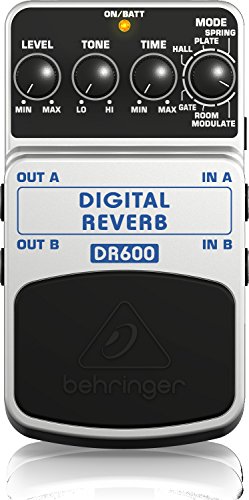 If you're on a limited budget but don't want to go for something basic and low quality, the Behringer DR600 DIGITAL REVERB Digital Stereo Reverb Effects Pedal has you covered. This digital reverb is as convenient to use as any other high-end digital reverb pedal. It's also a multiple reverb combined in one; there are six different reverb types, including plate, spring, room, hall, gate, and a modulated reverb. For musicians looking for even more options for all-in-one pedals, we recommend checking our multi-effects pedals review. In addition to these different reverbs, you have three other controls that let you make your sound even more distinctive. You have a level, time, and reverb tone to tweak the different modes even further. Tone knobs are a handy feature to look out for.
If you're on a limited budget but don't want to go for something basic and low quality, the Behringer DR600 DIGITAL REVERB Digital Stereo Reverb Effects Pedal has you covered. This digital reverb is as convenient to use as any other high-end digital reverb pedal. It's also a multiple reverb combined in one; there are six different reverb types, including plate, spring, room, hall, gate, and a modulated reverb. For musicians looking for even more options for all-in-one pedals, we recommend checking our multi-effects pedals review. In addition to these different reverbs, you have three other controls that let you make your sound even more distinctive. You have a level, time, and reverb tone to tweak the different modes even further. Tone knobs are a handy feature to look out for.
It's a small yet extremely hardy piece of gear designed for prolonged use. It runs on the 9V battery from Behringer, and it's incredibly affordable. You get all of these high-quality features for under $50. It's definitely the best reverb pedal under $50 (or even under $100!) If you're just starting to play around with the reverb effect, you'll find this compact pedal very easy to use, especially if you're after the great value.
Reverb Pedals
Understanding different reverb effects and what they do is extremely important. Reverb pedals (also known as an expression pedal) help to reflect sound off the surfaces of a room or venue. It creates a sort of live performance effect for your sound. You can adjust the sound anywhere from a small studio to a jam-packed hall. It's frequently used by rock and indie guitarists.
Types of Reverb Pedals
There are quite a few types of reverb pedals, and some of them get even more distinct when combined with other types of effects. Most have at least two reverb modes. Here are the main reverb types you should know about.
Spring Reverb
This is the most commonly used reverb type and features a spring that vibrates and a pickup that absorbs the vibration. With quite a distinctive reverb sound, spring reverbs were traditionally built into some amps. However, today things are done digitally. The decay is quick here, and the sound is brighter as a result. That's why so many guitarists love this effect in their compositions and will opt for this type of expression pedal.
Plate Reverb
If you replace the spring from the spring reverb with a metal plate, you get a plate reverb. The mechanism is pretty much the same; a pickup captures the vibration from the plate. It is a subtle reverb sound but with sudden enhancements that make it bright too.
Hall Reverb
These reverbs tweak your tones to make them sound as if you're playing them in an empty hall or room. With this type of expression pedal, you can choose which kind of room effect you want. E.g., a small room or a giant theater.
Room Reverb
This reverb mode is pretty self-explanatory. It reflects the sonic bounces of a small or middle-sized room. It has decay of less than a second and has a very discreet sound. Room reverb is good if you're looking for a subtle reverb effect and want to retain the warmth of your sound.
Chamber Reverb
This type of reverb pedal gives you a short decay time of 0.4 to 1.2 seconds. If you want a warmer sound, this reverb is the best for you. The reverb sound is also clearer with this type of pedal.
Gated Reverb
A gated reverb mode reduces the reverb or altogether silences it when the guitar's volume goes below a certain threshold. It can make the sound of the reverb quite big. Click here for the top noise gate pedals money can buy.
Digital Reverb Pedals
Most guitarists today use digital pedals; they are more convenient to use. They do these simulations digitally rather than using a spring or plate. If you're going for a more vintage sound, then a reverb with an actual spring is a better choice. Stompboxes are a lot more convenient for guitarists, so most of the reverb pedals you come across are digital.
Stereo Feature
Not all reverb pedals support stereo operation, so you should go for a stereo pedal specifically if you have a stereo rig. If most of your current pedals are stereo, you'll want a stereo reverb pedal, too, with stereo inputs. The reason is that the reverb pedal is usually the last effect in the chain, and if it is stereo, the results can be significantly different. Obviously, a stereo reverb combined with another stereo will produce the best stereo rig.
True Bypass or Buffered Bypass
True bypass or a buffer is a crucial consideration for a reverb pedal. A reverb pedal is similar to delay, i.e., the sound trails off for some time even after you've stopped playing. Imagine hitting the bypass footswitch while the reverb is still at work. You'll abruptly cut the effect, and the reverb tail won't naturally fade, a real bummer if you're playing live.
You'll find more pedals have a true bypass or a buffer or a combination of both. True bypass isn't a great addition to the reverb type. Buffer, on the other hand, is something you can work with. Once engaged, the sound will continue to fade naturally. The reverb effect will stay alive instead of what would happen if you used the true bypass.
True bypass is usually great with other effects, but it's not recommended for reverb for these reasons. However, if you plan on using the reverb continuously, then true bypass won't be a problem. It only creates a problem if you turn it on and off again and again. So when shopping for the best reverb pedals, your best option is to look for one with both true bypass and buffer.
Prices
Your budget is important to consider because there are pedals available for around $30 to $40, then there are those that cost upwards of $100. The price depends on the quality and brand of the expression pedal. Features, however, do not depend on the price. There are cheaper options with similar, if not the exact same, features and reverb modes as an expensive reverb. The key here is to shop for your own needs and budget.
It's easy to find the features you want at a lower price; a good reverb combines multiple reverb types. However, if you go for more expensive pedals, you'll get better quality and potentially advanced functions, such as ambient sounds. For beginners and those looking for simple pedals, spending a lot on reverb is probably not the best idea. You're better off sticking with classic reverbs.
Reverb and Delay
Reverb and Delay are somewhat similar, but there are differences. Delay repeats the guitar while the reverb reflects the sound of the guitar. The latter has more to do with defining the space of the sound. They are usually used together with delay coming first and the sound moving from delay to reverb. They are similar because they are used at the end of the signal chain. Delay and reverb are the last pedals in the chain. When used together, they create a more ambient sound with a unique presence.
Finding the Right Reverb Pedals
You can see that reverb pedals aren't all the same and the effects the different kinds of models produce depend on what you want. You can also combine reverb pedals with other effects like modulation or delay. The results will be even more distinctive.
Modern pedals have many functions that allow you to tweak the sound to your preferences. For example, you can have a single function or numerous reverb settings for adjusting your reverb tails and space according to your liking. If you want a simpler sound, go for the most basic pedal with fewer features. If you want to take control of every little detail in your sound, opt for digital reverbs that have many layers of controls. The most common control you will find on almost all reverbs is the decay which can be one level or several. Most will come with decay knobs for easy control.
Other considerations could include flexibility, as some guitarists prefer having more than one effect packed into one. The flexibility will allow you to switch between different kinds of reverbs. Also, you can have presets unless you prefer adjusting the settings manually.
Size is another important thing to consider. These pedals come in different sizes. Reverb is usually the last one to go on your pedalboard, so you should know how much space you have left on it to place the reverb. You can easily find the standard or mini-size reverb pedals from some of the most famous brands online.
FAQs
-
What is a Reverb Pedal?
Reverb is the result of sound hitting different surfaces at various amplitudes, which creates a complex echo/delay effect. This echo effect also carries physical information about a particular space. Reverb is a sound that depends on the surface’s measurements and depth. Different measurement and depth options put out different amplitudes and delays in sound, thus creating many effects.
Imagine that a musician needs a hall reverb in his music. What will he do to achieve it? Either he can shift his studio to a gigantic hall or use a simple instrument to get a halo-like effect. This is where a reverb pedal comes in. This compact instrument allows musicians to add available reverb to their music or instruments. The reverb pedal features effects like hall, washroom, arena, stadium, etc. All the information on depth and measurements of these particular effects are stored in the reverb pedal. This way, you can tweak the required setting without actually shifting to that particular surrounding.
-
What is a Reverb Pedal Used For?
Reverb pedals feature different surrounding effects in one compact box. Reverb pedals add various surrounding effects to music. For instance, if a guitarist wants to compile his guitar recordings as if he had recorded them in a hall, he can either shift his instruments to a hall or use an effect on a reverb pedal to get the same results. Basically, a reverb pedal is used to achieve sound simulations you would get in closed or open surroundings.
On the technical side, a reverb pedal alters the reverb signal you're sending to the amp (with stored settings) to get an alteration in how your guitar or instrument will sound.
-
Why Would I Need a Reverb Pedal?
It depends on your personal preference! Many musicians out there want a reverb pedal to alter the signals of their instruments and make them sound like they're playing in a different space. Others don't like editing their signals, favoring the original sound. (However, you will find models that preserve original sound waves.) So the answer depends on your personal choice.
-
What are the Different Types of Reverb Pedals?
Reverb pedals reverberate sound. There are five common types of reverbs.
Spring
This specific type of reverb is designed naturally by the mechanical system. Inside the system, the opposite sides of the spring are embedded with a transducer and a pickup so that the vibrations can be sensed. Although reverb pedals offer you a spring reverb, some guitar amps (like Fender) also provide a built-in spring reverb. The market offers analog and digital spring reverb pedals, but the analog ones are as rare as a hen’s tooth. Spring reverb pedals produce a “boingy” sound.
Room
Room reverb types output a natural acoustic space sound similar to a small room. The mechanism of this reverb reflects shorter sound waves that tend to wash off quicker. This type of reverb is mainly used to substitute slap-back echo-type sound. You can line it up with a slap-back delay to receive an enhanced effect. Room reverb pedals output a slap-back echo sound.
Hall
The hall reverb pedal has the same sound effect as a hall. The hall reverb pedal alters signals into sounding hall-like. Hall reverbs generate a much bigger surrounding effect than room reverb, with longer reflections and decay times. Hall reverb pedals are the best options for large sounding effects, longer decays, and complex reflections.
Plate
Plate reverb pedals are known for contributing short to long and focused reverbs. A plate reverb pedal will produce a studio effect. For more detailing, engineers added a delay for pre-delay and tweaked its frequencies with the help of EQ.
Shimmer
Shimmer, aka pitch-shafted reverb pedals, are commonly used with guitars. Basically, a shimmer reverb adds harmony to the guitar’s signal. This reverb includes octave up and down effects. Octave up on the wet signal produces a halo-like sound in the upper frequencies. Shimmer reverb pedals produce an unnatural ambiance pitch-shafted sound. If you're looking for an ambient reverb, look for a device with a shimmer mode.
Reverse
Reverse reverbs are engineered in studios by recording reverb tails and reversing them, leading signals into the sound source. Some of the pedals create interesting variations with reversed tails.
Gated
Ever experienced volume drops on your guitar? If yes, then you should consider buying a gated reverb pedal. This is a great reverb pedal to reduce or silence your guitar’s reverb level when it drops down to a certain threshold, providing a bigger sound without mixing it up.
Convolution
This reverb uses audio samples and algorithms to sound like real acoustic spaces.
Chamber
The chamber reverb pedal is used to output sound with a short decay time, resulting in more clarity. The reverbs last between 0.4 to 1.2 seconds, producing a warmer sound.
-
Selecting a Reverb Pedal on a Budget
Reverb pedals are the most important gadget for adding a different sounding output. There are many reverb pedals that offer you good quality for your money without spending a ton of cash.
TC Electronic Hall of Fame
The TC Electronic Hall of Fame ensures that every consumer can experience the joy of best reverbs. For more than 20 years, this was the trusted pedal used by leading music industry icons like Michael Jackson.
The pedal is packed with ten reverb sounds that you might not get on a budget. Decay, Tone and FX level controls give you more control over the reverb. You can also download custom reverb sounds from TC’s official website.
The TC Electronic Hall of Fame uses analog circuitry to ensure the tone’s consistency. Other components are digital, which means that any musician can easily use this pedal. You can access the battery compartment by unscrewing a single screw. The pedal’s housing is sturdy as it's made of metal. With ten built-in reverb sounds, custom downloadable reverbs, and analog circuitry, the TC Electronic Hall of Fame gives you a lot for a low price.
Behringer Digital Reverb DR600 Effects Pedal
The DR600 by Behringer gives you state-of-the-art reverbs on a budget. This reverb pedal is engineered with 24-bit digital converters that give you prime access to full, thick sound.
This box offers four reverb modes: spring, plate, hall, and gate. It also features a room modulate mode, which produces chorus-like effects. The DR600 contains two expression pedal input and output ports for routing signals into a stereo (for stereo operation) or feeding towards the amplifier for a boosted sound.
Status LED lights notify the user if the box is in use or not. This pedal can be powered with a battery or a DC adapter. With two input and output ports, four modes, and one modulated spring mode, this pedal is worth every penny.
Behringer Reverb Machine RV600
Are you looking for a pedal that packs a variety of natural-sounding modes at an affordable price? Then the RV600 by Behringer is a great option!
This reverb machine offers 11 different reverb modes to mimic any sound space. By rotating the knob, you can access various modes like hall, chamber, tile, echo, etc. This machine is also equipped with a separate reverb mix, decay, tone, and more for full control. You also get a reverb tail switch.
With the RV600, you get to experience studio-class reverbs and studio-quality sounds with the press of a button. Likewise, the machine features Real Sound Modelling DSP technology with natural algorithms to rock your reverbs. You also get two input and output ports for connecting amps. This bad boy runs on a 9V battery. With the Real Sound Modelling DSP technology, more than 11 reverb options, and a studio class button, this reverb pedal offers the most variety under a rock-bottom price point.
-
Best Reverb Pedal
From expensive to cheap, we encounter all types of reverb pedals available. So here are the best of the bunch!
Electro-Harmonix HOLY GRAIL NANO reverb pedal
The Holy Grail Nano by Electro-Harmonix is counted among the best reverb pedals. This pedal has a compact design and a low price. Holy Grail will redefine your experience with its classic spring reverb, and you’ll get lost in the mesmerizing quality of its hall reverb. At last, you’ll face the unforgettable flerb, rarely found in high-end reverb pedals.
The spring mode offers the finest reverbs. The hall mode sounds spacious, while the flerb mode offers a uniquely ethereal sound. Although this machine provides only three modes, it guarantees you the natural feel in all of them, unlike those crafted with weak algorithms. This pedal is a great choice.
Earthquaker Devices Dispatch Master
The company Earthquaker Devices believes a pedal should be compact, simple to use, and contain a lot of features. They also believe that pedals should work correctly all the time. That's why every one of their products is hand-made, hand-tested, and guaranteed for life.
The Dispatch Master by Earthquaker Devices is among the most popular reverb pedal in any music store. With its small size and lush sound, this pedal reverb is capable of working out wonders. It can produce a max of 1.5 sec of delay time with infinite repeats and cavernous reverb. The delay signal outputs clear and strong sound with null after-effects or degradation. Similarly, the repeat signal decays into a good ambient swell with no oscillation.
The delay signal outputs clear and strong sound with null after effects or degradation. Similarly, the repeat signal decays into a good ambient swell with no oscillation. For giving a thick reverb, repeat control can be tweaked (while using reverb with no delay) to give more depth and dimensions to the sound. With many controls, a compact design, and a lush sound, this pedal smashes all the records.
If you liked this review, please leave a positive rating:


